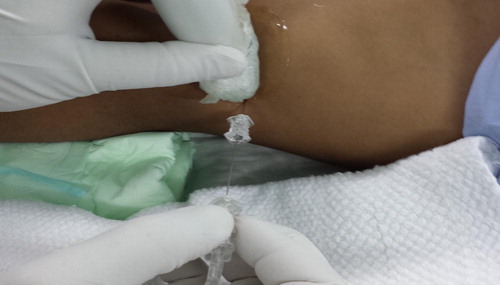Abstract
Since introduction of transversus abdominis plane (TAP) block to pediatric practice, ultrasonography is considered the standard of care to perform such block in pediatric age group.
In spite of the rarity of reported complication of the block in literatures, many practitioners still avoid performing such block in pediatric age group giving the shallow depth of plane and probability of intra-abdominal organs trauma.
I am explaining a new approach entailed using Ultrasound (US) guided spinal needle through introducer in 3 years old child.
This technique has a potential to make the block more approachable as it decreases the probability of intra-abdominal organs trauma.
Keywords:
1 Case report
3-years-old 16-kg ASA-1 child presented for open Left orchiopexy.
Intravenous Midazolam 0.1 mg/kg was administered in pre-op holding area.
General Anesthesia was induced using propofol 2 mg/kg, followed by LMA #2 placements. Anesthesia was maintained with 1MAC sevoflurane in 40% O2/air mixture.
Left side TAP block was carried under aseptic conditions under US guidance.
Abdominal scan revealed normal structures. Transversus abdominis plane was identified at 1.2 cm from the skin.
Skin was punctured using 22 g, sharp end, 1-in. introducer needle.
The introducer observed piercing the external oblique muscle utilizing US in-plane approach.
Then a 24 g, pin point, 2.5-in., spinal needle (SMMP-KSA) was inserted through the introducer till the tip reached the target plane (). Separation of Internal oblique muscle (IOM) and transversus abdominis muscle (TAM) by local anesthetics was confirmed with Live ultrasonography where 6 ml of 0.125% bupivacaine injected in the plane.
Surgery commenced uneventfully within 82 min.
Patient received Ondansetron 0.2 mg/kg for nausea prophylaxis.
LMA was removed at conclusion of anesthesia. Patient was transferred to PACU for conscious and comfortableness.
During his 40 min PACU stay patient required no further analgesic.
2 Discussion
TAP block was introduced to practice in 2001 when Rafi explained a blind technique involving a blunt needle insertion with two pops through different layers of abdominal muscles [Citation1].
The targeted plane contains T7-T12 intercostal nerves, the ilioinguinal and iliohypogastric nerves and the lateral cutaneous branches of the dorsal rami of L1-L3 offering good analgesia below umbilical level [Citation2].
Hebbard et al. advocated using US performing safer blocks especially in children [Citation3].
In spite of complications secondary to TAP block considered rare and unlikely, local anesthetic toxicity, intraperitoneal injection [Citation4], peritonitis, trauma to major structures and weakness of upper abdominal muscles are still of concerns.
Liver trauma [Citation5,Citation6] and peritonitis [Citation6] have been reported secondary to such block.
Children in particular offer unique challenge as their skin and ligaments are more lax, their peritoneum is shallower and their baseline respiratory rate is higher.
These factors theoretically make them vulnerable to have major complications in spite of the rarity of reported complications in literatures.
Rafi illustrated blind technique using sharp 18 g needle to create a skin puncture where second blunt block needle is inserted through [Citation1].
Difficulties to locate the initial puncture site could lead to uncontrolled initial skin puncture with blunt needle. Inadvertent penetration of peritoneum and possible major intra-abdominal structure could result from blind 1st puncture.
Using a short cutting end introducer needle threaded under US guidance till EO pierced followed by 2nd needle through has a potential to alleviate the risk of uncontrolled puncture resulting in inadvertent major organs trauma and hematoma.
Possible trauma to the EO muscle with possible abdominal muscle hematoma formation is of a lesser concerns using a sharp introducer.
3 Conclusion
This technique has a potential to make the block safer as it offers better control and visualization of needle from the moment of initial skin puncture.
Using two needles will allow less perpendicular approach too.
Application of this technique could be extended to adult population especially the obese patients where block is more challenging to perform.
Conflict of interest
The authors declare that there are no conflict of interests.
Notes
Peer review under responsibility of Egyptian Society of Anesthesiologists.
References
- A.RafiAbdominal field block: a new approach via the lumbar triangleAnesthesia56200110241026
- Y.ShibataY.SatoY.FujiwaraT.KomatsuTransversus abdominis plane blockAnesth Analg1052007883
- P.HebbardY.FujiwaraY.ShibataC.RoyseUltrasound-guided transversus abdominis plane (TAP) blockAnesth Intens Care352007616617
- Z.B.JankovicS.G.PollardM.M.NachiappanContinuous transversus abdominis plane block for renal transplant recipientsAnesth Analg109200917101711
- M.FarooqM.CareyA case of liver trauma with a blunt regional anesthesia needle while performing transversus abdominis plane block regionalAnesth Pain Med332008274275
- P.LancasterM.ChadwickLiver trauma secondary to ultrasound-guided transversus abdominis plane blockBr J Anaesth1042010509510

